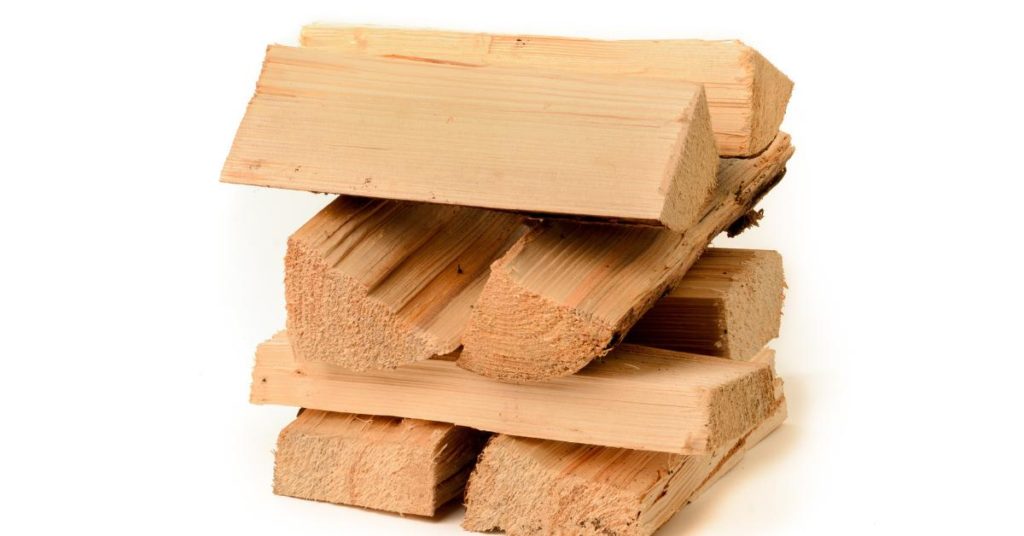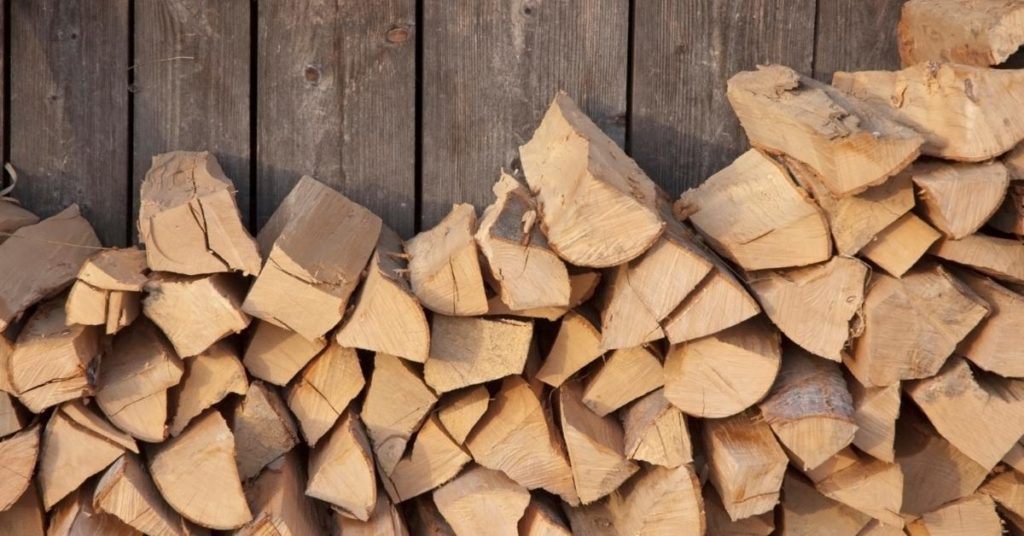Burning unseasoned wood in a fireplace is never advisable. The presence of excess moisture makes it difficult to light, it produces too much smoke, and is generally inefficient for burning.
Unseasoned wood can also be dangerous due to the creosote that accumulates in your chimney and can cause a possible chimney fire. Burning your firewood in this manner is not an effective use of it and can result in unnecessary expenses.
TABLE OF CONTENTS:
- What is Firewood Seasoning?
- What Happens if You Burn Unseasoned Wood?
- Is it Illegal to Burn Unseasoned Wood?
- How Can You Tell if Firewood is Seasoned Enough?
- How To Dry Firewood Quickly
- How to Tell if the Wood is Not Seasoned
- What is the difference between unseasoned and seasoned firewood?
- Types of Wood you Should Avoid Burning
- How to Tell if your Firewood is Seasoned Correctly
- Is it Safe to Burn Wet or Green Wood?
- What Wood Can You Burn Without Seasoning?
- How Often Should I Replace My Stored Firewood?
- The Best Way to Store Firewood for Burning
- Conclusion
What is Firewood Seasoning?
Firewood seasoning is the process of drying out wood to reduce its moisture content and make it suitable for burning. The traditional rule of thumb is to season firewood for at least six months before the heating season.
Some hardwoods require at least one to two years of seasoning. The wood will dry out and become lighter, making it easier to store and transport.
What Happens if You Burn Unseasoned Wood?
If you burn unseasoned wood, you’ll likely notice a few things. First, it will be harder to start and keep a fire going. The wood will produce more smoke and soot, which can create a build-up in your chimney.
This build-up can be dangerous, as it can ignite and cause a chimney fire. In addition, unseasoned wood burns less efficiently, so you’ll need to use more to heat your home.
Is it Illegal to Burn Unseasoned Wood?
While it’s not necessarily illegal to burn unseasoned wood, it’s not recommended. Burning unseasoned wood can violate air quality regulations in some areas, producing more pollutants than seasoned wood. Before you burn unseasoned wood, it is essential to check if it is allowed by your local authority.
Firewood regulations for your home state can be easily accessed from this Firewood Map from dontmovefirewood.org
How Can You Tell if Firewood is Seasoned Enough?
The best way to tell if your firewood is seasoned enough is by checking the moisture content. You can utilize a moisture meter to measure the moisture content of the firewood.
A 20% or less moisture content is considered seasoned enough for burning. If the moisture content is above 20%, it is essential to continue seasoning the firewood before using it.
General Tools MMD4E Digital Moisture Meter on Amazon
How To Dry Firewood Quickly
On a daily basis, we use firewood to grill, cook or warm our home, and fully-seasoned wood is needed for all these jobs. But what happens when we have wood that has not fully dried out? Below are the best methods you can use to dry out your logs as fast as possible:
- You need to split the wood into pieces to increase the surface area for the wood to dry faster. Using the sun to try the wood will hit the piece directly and dry the moisture
- Use a kiln or a specialized drying device to dry the wood quickly. This can be expensive
- Use a solar kiln which is a low-cost way to dry firewood quickly. A solar kiln uses the heat from the sun to dry the wood, and it can dry firewood in just a few weeks if your conditions are right
- Stacking the wood in a well-ventilated area with plenty of sunlight.
This will help draw out moisture from the wood more quickly than if stored indoors or in a shady area

How to Tell if the Wood is Not Seasoned
If you plan to burn wood in a fireplace or stove, it’s essential to use seasoned wood. Unseasoned wood contains too much moisture, leading to increased creosote build-up, reduced heat output, and difficulty lighting the fire.
Unseasoned wood is heavy, the bark will still have green patches and the moisture content will be too high to burn efficiently.
What is the difference between unseasoned and seasoned firewood?
Unseasoned firewood is wood that has been recently cut and has a high moisture content. The wood has low efficiency due to high moisture content and produces a lot of smoke.
In contrast, seasoned firewood is wood left to dry for six to twelve months, thus much drier. This type of wood has a lower moisture content, burns more effectively, and produces less smoke.
Types of Wood you Should Avoid Burning
There are certain types of wood that you should avoid burning, as they can release harmful chemicals or create excessive creosote build-up. These include painted or treated wood and wood from toxic trees that produce excessive smoke.
Examples of trees to avoid burning include pine, cedar, and eucalyptus. Instead, opt for hardwoods such as oak, maple, and birch, as these burn more cleanly and efficiently.
How to Tell if your Firewood is Seasoned Correctly
You can perform a few simple tests to determine if your firewood is seasoned correctly. First, check the color of the wood. Seasoned wood will be darker in color than unseasoned wood. Next, try knocking two pieces of wood together.
The wood is likely seasoned if they make a hollow, clunking sound. Finally, check the moisture content of the wood using a moisture meter. Seasoned wood should have a moisture content of less than 20%.
Is it Safe to Burn Wet or Green Wood?
Burning wet or green wood is unsafe as it produces more smoke than seasoned wood, which can harm your health, especially when used in the home fireplace. Burning wet or green wood also creates creosote deposits in your chimney, leading to a potentially dangerous fire if left unchecked.

What Wood Can You Burn Without Seasoning?
Wood burning is a popular way to heat your home and create beautiful works of art. Before you can burn wood, however, it needs to be seasoned. Seasoning wood involves drying it out for a period of time so that the moisture content is reduced.
The most common types of wood that can be burned without seasoning are softwoods such as pine or aspen, which are easier to burn than hardwoods. Softwoods have minimal grain and therefore don’t require seasoning before burning.
Some hardwood species of Birch also have a relatively low moisture content and can arguably be burned without seasoning, but it performs better fully seasoned.
Related Article: Is Ash good for firewood?
It is important to note that all wood should be seasoned before burning in order to reduce smoke and creosote build-up in your chimney.
How Often Should I Replace My Stored Firewood?
It’s important to replace your stored firewood regularly to ensure you have access to quality wood for burning. For better results, it is essential you replace your stored firewood every 6-12 months, depending on your usage. This will help ensure that your wood is properly seasoned and ready for burning when needed.
The Best Way to Store Firewood for Burning
Storing firewood properly is essential for burning it safely and efficiently. The best way to store firewood is outside, with the cut ends exposed to the air. It should be kept off the ground and stored neatly in a dry area away from structures or buildings. Trimming brush away from the pile and using a string trimmer for tall grass can also help dry the wood.
Related Article: Killer firewood storage ideas!
Other tips for storing firewood:
- Don’t leave scraps or kindling lying around
- Place the wood on a raised platform or pallet to ensure proper air circulation
- Cover your stack of wood with a tarp to protect it from rain and snow
- Keep your storage space open and well ventilated
- Use logs of similar size when stacking them together
- Store wood at least five feet away from any structure or building
Related Article: How to keep firewood dry
Conclusion
Burning unseasoned wood in a fireplace is never advisable due to the high moisture content that causes it to smoke more. This can lead to creosote build-up in your chimney, increasing the fire risk.
Burning unseasoned wood is also an inefficient use of firewood and money. To avoid these risks, seasoning your wood for at least 6 months before burning it is best.


Leave a Reply